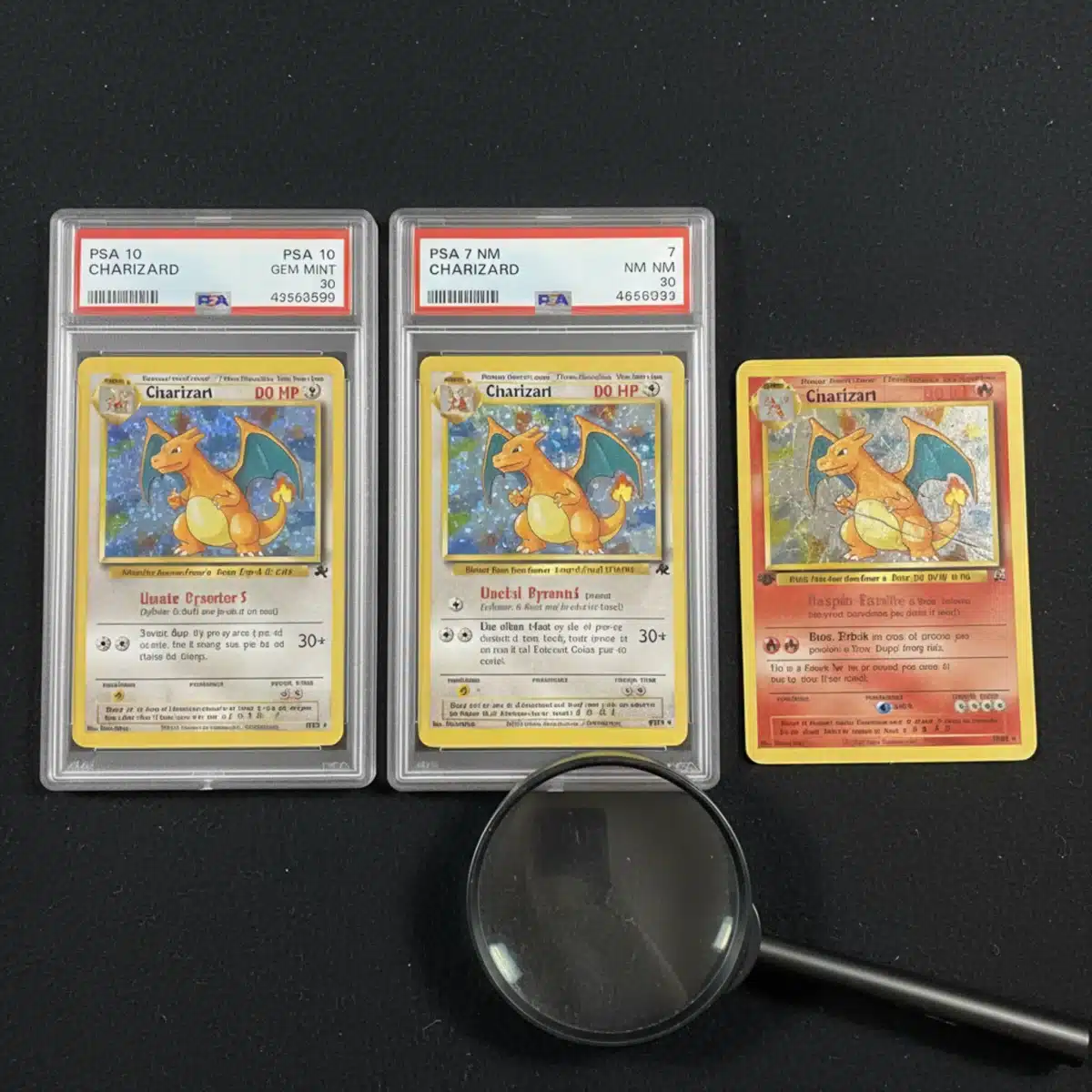Pokémon TCG: Maximize Resale Value Through Card Grading

Advertisements
Understanding professional grading for your Pokémon TCG cards is crucial for collectors aiming to significantly enhance their resale value by authenticating condition and rarity.
Are you holding onto a treasure trove of Pokémon cards, wondering if their true potential value is hidden beneath their raw state? For many collectors, the answer lies in professional grading. This ultimate guide to Pokémon TCG grading for maximum resale value will walk you through everything you need to know, transforming your collection from mere cards into certified investments.
Anúncios
Understanding the Basics of Pokémon Card Grading
Before diving into the intricate details of maximizing resale value, it’s essential to grasp what card grading actually entails. Professional grading involves submitting your Pokémon cards to an independent third-party service that evaluates their condition, authenticates them, and assigns a numerical grade. This grade is a universal indicator of the card’s quality, ranging typically from 1 (poor) to 10 (gem mint or pristine).
Anúncios
The primary goal of grading is to provide an unbiased assessment of a card’s condition, which directly impacts its market value. A higher grade signifies better condition, translating into a significantly higher price tag in the secondary market. This process removes subjectivity and offers buyers confidence in their purchase, making graded cards highly sought after by serious collectors and investors.
Why Grading Matters for Resale Value
The impact of grading on resale value cannot be overstated. A raw, ungraded card, even if seemingly perfect, will almost always fetch less than its professionally graded counterpart. This is due to the authentication and condition verification that grading companies provide. Buyers are willing to pay a premium for assurance, especially for rare and expensive cards.
- Authentication: Grading companies verify the card’s authenticity, protecting against counterfeits.
- Condition Assurance: A numerical grade provides an objective measure of the card’s state.
- Market Liquidity: Graded cards are often easier to sell and command higher prices.
- Protection: Cards are encapsulated in tamper-evident, protective cases, preserving their condition.
In essence, grading transforms a collectible into a verifiable asset. It standardizes the evaluation process across the hobby, allowing for clearer comparisons and more confident transactions between collectors worldwide. This standardization is what fuels the premium pricing seen on high-grade cards.
Choosing the Right Grading Service for Your Cards
Selecting the appropriate grading service is a critical decision that can significantly influence your card’s perceived value and market acceptance. Several reputable companies offer grading services, each with its own nuances, pricing, and turnaround times. Understanding these differences is key to making an informed choice for your Pokémon TCG collection.
The three most prominent grading companies in the Pokémon TCG market are PSA (Professional Sports Authenticator), BGS (Beckett Grading Services), and CGC (Certified Guaranty Company). While all provide professional grading, their grading scales, sub-grades, and market reputations can vary, affecting which service is best for specific cards or collecting goals.
Key Grading Companies and Their Specialties
Each major grading company has carved out its own niche and reputation within the collecting community. Researching their specific criteria and market perceptions is crucial before submission.
- PSA (Professional Sports Authenticator): Widely recognized as the industry standard, especially for vintage Pokémon cards. PSA’s 1-10 scale is straightforward, and a PSA 10 (Gem Mint) is highly coveted and often commands top dollar. Their slabs are identifiable and generally preferred for broad market appeal.
- BGS (Beckett Grading Services): Known for its meticulous grading and sub-grades (Centering, Corners, Edges, Surface) that provide a detailed breakdown of a card’s condition. BGS offers a Pristine 10 and a coveted Black Label 10 (perfect 10s across all sub-grades), which can fetch even higher prices than a PSA 10 for certain cards.
- CGC (Certified Guaranty Company): A newer entrant to the TCG grading scene but rapidly gaining popularity due to its transparent grading scale, detailed sub-grades, and competitive pricing. CGC’s Pristine 10 and Perfect 10 grades are also highly regarded, and they offer a robust service for both modern and vintage cards.
Consider the card’s rarity, potential grade, and your target market when choosing a service. For instance, a vintage Charizard might benefit most from PSA for its market recognition, while a modern full-art card could thrive with BGS’s detailed sub-grades or CGC’s growing reputation.
The Grading Process: What to Expect
Once you’ve selected a grading company, understanding their submission process is the next crucial step. While specifics may vary slightly between services, the general workflow remains consistent. This involves careful preparation, submission, evaluation, and finally, the return of your graded cards.
Each step is vital for ensuring your cards are handled properly and graded fairly. Mishandling during preparation or submission can inadvertently lower a card’s potential grade, impacting its future resale value. Therefore, meticulous attention to detail is paramount throughout the entire journey.
Preparing Your Cards for Submission
Proper preparation is arguably as important as the card’s inherent condition. A poorly prepared card might receive a lower grade due to preventable issues like dust, fingerprints, or improper packaging.

- Cleaning: Gently clean the card surface with a microfiber cloth to remove dust and smudges. Avoid harsh chemicals or excessive pressure.
- Sleeving: Place the card in a soft sleeve (penny sleeve) immediately after cleaning.
- Top-loading: Insert the sleeved card into a semi-rigid card holder or top-loader for added protection.
- Packaging: Securely package your cards within a sturdy box with adequate padding to prevent movement during shipping.
Always double-check the grading company’s specific submission guidelines, as they often provide detailed instructions on how to package and ship your cards to ensure their safety and proper processing. Failure to follow these guidelines could lead to delays or even rejection of your submission.
Key Factors Influencing a Card’s Grade
Professional graders meticulously examine several key attributes of a card to determine its final grade. Understanding these factors can help you pre-screen your cards and estimate their potential grade, allowing you to prioritize which cards to submit for maximum return on investment.
These factors are universally applied across all major grading companies, though the weight given to each might vary slightly. A perfect card would exhibit flawless characteristics in all these areas, achieving the coveted Gem Mint 10 or Pristine 10 grade.
The Four Pillars of Card Condition
The grading scale is built upon four main categories, commonly referred to as the ‘four pillars’ of card condition. Each plays a crucial role in the overall assessment:
- Centering: This refers to how evenly the artwork is printed on the card. Ideal centering means equal borders on all four sides. Even a slight off-center can reduce the grade significantly.
- Corners: Graders examine all four corners for any signs of wear, fraying, creasing, or whitening. Sharp, crisp corners are essential for high grades.
- Edges: The edges of the card are inspected for chipping, nicks, or wear. Smooth, clean edges without any indentations or rough spots are preferred.
- Surface: This category covers the entire card’s surface, including the artwork, text, and holographic areas. Graders look for scratches, print lines, indentations, dimples, silvering, and any other imperfections.
Beyond these four, other minor factors like print defects, factory errors, and even the overall eye appeal can subtly influence a grader’s final decision. A comprehensive understanding of these elements equips you to better assess your collection.
Maximizing Resale Value Post-Grading
Achieving a high grade is just one part of the equation; effectively marketing and selling your graded cards is the next step to truly maximize their resale value. The secondary market for graded Pokémon TCG cards is vibrant and competitive, requiring a strategic approach to ensure you get the best possible return on your investment.
Successful selling involves choosing the right platform, presenting your cards professionally, and understanding market trends. A well-executed sale can significantly amplify the financial benefits of grading your collection, turning your hobby into a profitable venture.
Selling Strategies for Graded Cards
Several avenues exist for selling graded Pokémon cards, each with its own advantages and disadvantages. Tailoring your selling strategy to the specific card and your personal goals is crucial.

- Online Marketplaces: Platforms like eBay are popular for their wide reach. High-quality photos, detailed descriptions, and transparent pricing are essential for success here.
- Specialized Auction Houses: For extremely rare or high-value cards, auction houses dedicated to collectibles can attract serious buyers and achieve premium prices.
- Social Media and Forums: Targeted groups on platforms like Facebook or Reddit can connect you directly with interested collectors, potentially reducing selling fees.
- Local Card Shops/Conventions: While not always offering the highest prices, these venues provide immediate liquidity and can be great for networking.
Always research recent sales data for similar graded cards to set a realistic and competitive price. High-resolution images of both the front and back of the graded slab, along with clear descriptions of any unique attributes, will enhance buyer confidence and interest.
Common Mistakes to Avoid in Card Grading
The journey of grading Pokémon cards for resale value is fraught with potential pitfalls. Avoiding common mistakes can save you time, money, and frustration, ensuring a smoother process and better outcomes for your collection. Many of these errors stem from a lack of research or underestimating the precision required in the grading world.
From misjudging a card’s condition to choosing the wrong service, each misstep can detract from your ultimate goal of maximizing profit. Learning from the experiences of others and being diligent in your approach will serve you well.
Preventable Errors That Impact Value
Being aware of these common missteps can significantly improve your grading success rate:
- Overestimating Condition: Many collectors view their cards through rose-tinted glasses. Be realistic about a card’s flaws; a magnifying glass can reveal imperfections not visible to the naked eye.
- Submitting Low-Value Cards: Not all cards are worth grading. The cost of grading can sometimes exceed the potential increase in resale value for common or less desirable cards. Research market trends before submitting.
- Improper Cleaning: Aggressive cleaning can damage a card’s surface, creating new flaws. Always use appropriate tools and techniques, or seek professional cleaning services.
- Poor Packaging: Cards can get damaged in transit if not securely packaged. Use sturdy boxes, bubble wrap, and follow the grader’s specific shipping instructions.
- Ignoring Sub-Grades (BGS/CGC): For services offering sub-grades, understand how they contribute to the overall grade. A low sub-grade in one area can pull down an otherwise high-grade card.
By diligently avoiding these common errors, you can streamline your grading process, protect your investment, and ultimately achieve higher resale values for your cherished Pokémon TCG cards. Patience and thoroughness are your best allies.
The Future of Pokémon TCG Grading and Investing
The Pokémon TCG market is dynamic, influenced by new releases, anime, games, and the ever-evolving landscape of collectibles. Understanding these trends is crucial for long-term investing and maximizing the value of your graded cards. The hobby has matured significantly, moving beyond simple collecting to a recognized asset class for many.
As the market continues to expand and attract new collectors and investors, the importance of professional grading will only grow. Staying informed about market shifts and anticipating future trends can give you a significant edge in your Pokémon TCG investment strategy.
Emerging Trends and Long-Term Value
Several factors are shaping the future of Pokémon TCG grading and investment:
- Increased Mainstream Acceptance: Pokémon cards are increasingly recognized as legitimate investments, attracting more capital and driving up demand for high-grade specimens.
- Focus on Scarcity and Rarity: Ultra-rare, limited-edition, and vintage cards will likely continue to appreciate, especially in high grades, as their supply diminishes.
- Digital Integration: The potential for digital ownership or NFTs linked to physical cards could revolutionize authentication and ownership tracking, though this is still nascent.
- Evolving Grading Technologies: Grading companies may adopt AI and advanced imaging to enhance consistency and precision, further solidifying the integrity of graded cards.
For collectors and investors, this means a continued emphasis on acquiring high-grade, desirable cards. Diversifying your collection with a mix of vintage, modern chase cards, and unique promos can hedge against market fluctuations. The long-term outlook for professionally graded Pokémon TCG cards remains robust, provided you stay informed and strategic.
| Key Aspect | Brief Description |
|---|---|
| Grading Purpose | Objective assessment of card condition and authenticity to boost market value. |
| Key Graders | PSA, BGS, and CGC are leading services, each with distinct grading scales and market appeal. |
| Condition Factors | Centering, corners, edges, and surface are critical determinants of a card’s final grade. |
| Maximizing Value | Proper preparation, strategic submission, and effective marketing are essential for high returns. |
Frequently Asked Questions About Pokémon Card Grading
The “best” company often depends on your card and goals. PSA is a market leader for vintage cards, BGS is known for detailed sub-grades and the coveted Black Label, while CGC offers competitive pricing and strong growth. Researching market preferences for specific cards is recommended.
Grading costs vary based on the service tier, declared value of the card, and turnaround time. Prices can range from $15-$30 for slower, lower-value submissions to hundreds or even thousands for expedited services on high-value cards.
Four primary factors determine a card’s grade: centering (how even the borders are), corners (sharpness and wear), edges (smoothness and nicks), and surface (scratches, print lines, and imperfections). Each is meticulously inspected by graders.
No, not always. Grading is most beneficial for rare, highly sought-after cards in excellent condition, where the potential increase in resale value significantly outweighs the grading cost. Common cards often don’t yield a profitable return after grading expenses.
Carefully clean the card with a microfiber cloth, place it in a penny sleeve, then a semi-rigid card holder or top-loader. Package securely in a sturdy box with ample padding to prevent movement and damage during shipping to the grading company.
Conclusion
Embarking on the journey of Pokémon TCG grading is a strategic move for any collector looking to unlock and maximize the true resale value of their cards. By understanding the grading process, selecting reputable services, meticulously preparing your submissions, and navigating the secondary market effectively, you transform your beloved collection into a verifiable and valuable asset. The investment in grading is often well worth it, providing authentication, protection, and a significant boost to market desirability. As the Pokémon TCG world continues to grow, professionally graded cards stand out as premier collectibles, offering both nostalgic joy and substantial financial returns.





